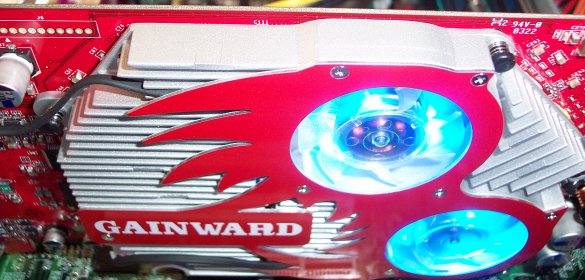Looks and features
One of the small criticisms we had against Gainward's very own FX 5900 Ultra was its appearance. That card appeared to be nothing other than a reference design with a couple of token Gainward stickers. When one is shelling out £400+ for a high-end video card, looks, or lack of them, do become important. That's one area where we'd hoped Gainward would apply its personal touch.

Now that's a little more like it. Our thoughts lead us to believe that the lower core clock of the standard FX 5900 would, at 400MHz vs. the 450MHz of the Ultra, allow card manufacturers to be a little more creative in the cooling department. The card, too, is also more in tune with Gainward's usual presentation, and, quite importantly, the whole design is a single-slot affair. One extremely irritating difficulty we ran into was the just how time consuming it was to remove the card from a motherboard that uses an AGP locking mechanism. The bottom of the huge heatsink sat perfectly flush with the lock, so that one couldn't lever it out at all. The motherboard tray had to be removed to gain better access to the lock and card. Just how annoying is that ?.
The two fans, a la Leadtek, incorporate four blue LEDs each. These stay permanently on when the card is running. Their brightness took this reviewer a little by surprise, as they're almost bright enough to replace a mediocre cold cathode.

The above picture gives you some idea of their case-lighting ability. A nice, individual touch from Gainward and one that's bound to be appreciated by enthusiasts and modders everywhere. The large aluminium block takes care of both the GPU and memory cooling in one fell swoop. Its large heat dispersal area and lower clocked core allow Gainward to use a couple of quieter fans on this model. Gainward use thermal paste in between the GPU and heatsink and thick thermal tape for RAM heat transfers.

Gainward feel that there's little to be gained from cooling the back of the card. Whereas the FX 5900 Ultra ships with a whopping 256MB of on-board 850MHz RAM, the non-Ultra's happy with the industry-standard 128MB. The outline of the 8 DDR-I TinyBGA RAM modules is clear to see. One of the questions we'll be posing ourselves is whether having an extra 128MB of RAM is hugely beneficial in today's games.

The 1200 XP is a little shorter than its 1600XP FX 5900 Ultra stablemate. That allows the now ubiquitous MOLEX connector to be attached in a horizontal fashion. Further, the whole board appears to have a cleaner look to it. The FX 5900 Ultra may be NVIDIA's ultimate expression of consumer-level graphics power, but we feel that the FX 5900 will undoubtedly appeal to a broader cross-section of users.

Nothing new here, or is there?. It's immensely pleasing to see a card based on the potent GeForce FX 5900 core not taking up a single PCI slot (Ed., read your reviews properly :P). Kudos to Gainward and NVIDIA for getting right back on track after the two-slot (AGP + PCI) FX 5800 / FX 5900 Ultras. A twin DVI model would really be a godsend for TFT users, too.

Expensive graphics aren't all about grunt and FPS, contrary to popular opinion. THine are charged with transmitting the DVI signal to the interface on the back. This particular model has the ability to run flat panel screens at up to 1600x1200x32 (UXGA format). The transmitter caused no problems when outputting to a Samsung 181T. On the right is Philips' 7108AE encoder / decoder chip. It's been around the block a few times now and provides input/output resolutions of up to 1280x1024. Gainward has been specifying various Philips chips for a while now.
The Gainward 1200 XP looks fabulous and arrives with all the connections one would expect. It's gratifying to see a non-generic design.









